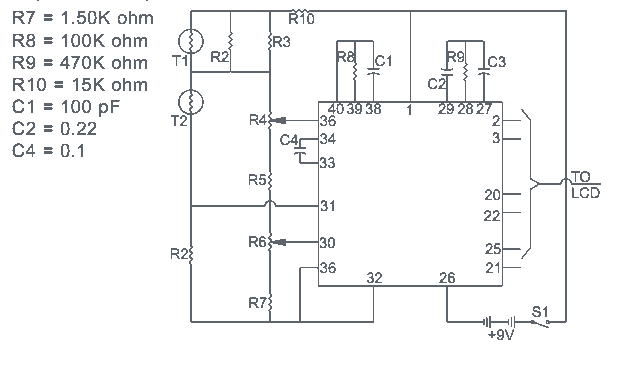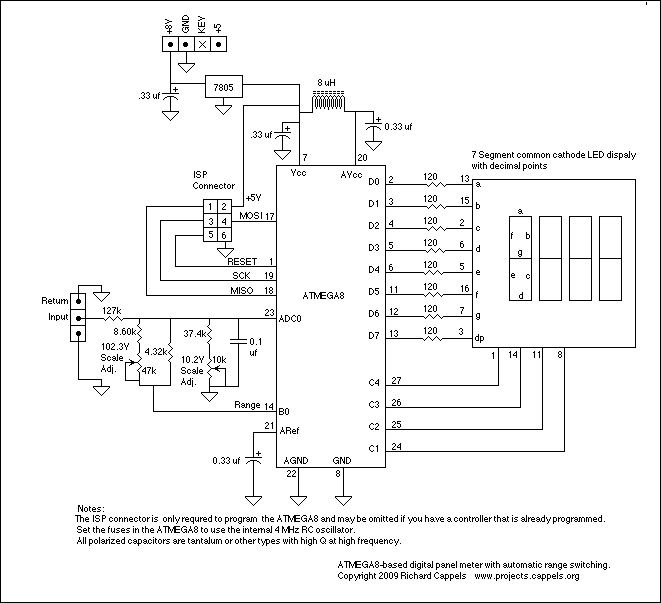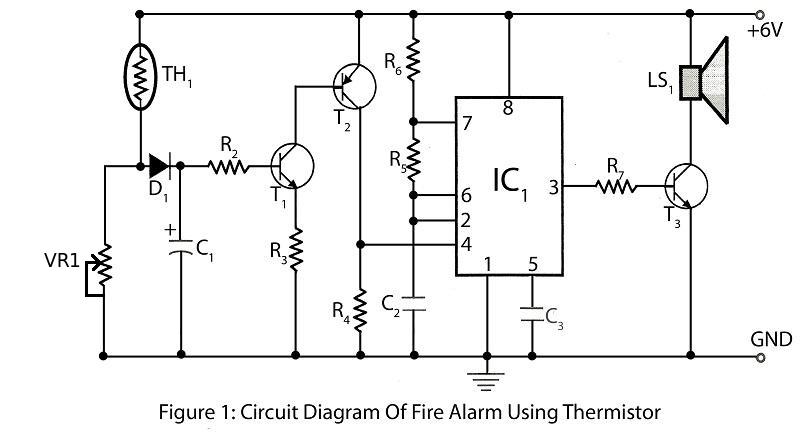
Digital Thermometer using

The most common application for the NTC thermistor is temperature measurement. Accurate temperature measurement can easily be accomplished by interfacing a Wheatstone Bridge, 6K/30K ohm thermistor network and a digital voltmeter integrated circuit as illustrated in Figure 5. The IC consists of an analog to digital converter with built-in 3-1/2 digit LCD driver providing a resolution of 0.1°C. Using the 6K/30K ohm thermistor network makes it possible to achieve an overall system accuracy of ±0.4°C from 0°C to 100°C. This digital thermometer can easily be interfaced with additional circuitry to provide a temperature control circuit with a digital display. The advent of low-cost microcontrollers used with precision interchangeable NTC thermistors provides the design engineer with unlimited design possibilities for temperature measurement and control systems. These systems are relatively inexpensive to produce yet offer very high temperature accuracy and various software-controlled outputs. For example, a microcontroller system utilizing remote thermistor sensors can monitor and control the temperature in several locations in an office building. For this case, the microcontroller is comprised of a built-in microprocessor, analog to digital converter, RAM, and several digital inputs/outputs. The complete system utilizes the microcontroller, multiplexer, EPROM, digital display, keypad, and display driver. The microcontroller is programmed in assembler language. The temperature measurement is calculated within the microcontroller using the resistance versus temperature algorithm and the a, b, and c constants for the specific thermistor resistance and curve material. Refer to the Steinhart Equation on page 5. An alternative method to convert the thermistor resistance to temperature is to program a lookup table in EPROM. After programming, the microcontroller tells the multiplexer to send back temperature data from a particular zone (room in the office building) and converts the resistance of the thermistor into a temperature reading. The microcontroller can then turn on or off the heating or air conditioning systems in a specific zone. The thermistor/microcontroller system can be used for security, temperature control, monitoring activities, and many other applications. The possibilities are endless.
The described system utilizes an NTC (Negative Temperature Coefficient) thermistor as the primary temperature sensing element. The Wheatstone Bridge configuration allows for precise measurement of the thermistor's resistance, which varies inversely with temperature. The 6K/30K ohm thermistor network is specifically chosen to optimize the range and accuracy of temperature readings from 0°C to 100°C. The digital voltmeter integrated circuit performs the necessary analog-to-digital conversion, enabling the microcontroller to process the temperature data.
The microcontroller, which serves as the central processing unit of the system, integrates various components including an analog-to-digital converter (ADC), RAM for temporary data storage, and digital I/O ports for interfacing with external devices. The inclusion of a multiplexer allows for the selection of multiple thermistor inputs, facilitating monitoring across different zones within an environment, such as an office building.
Programming the microcontroller in assembler language ensures efficient execution of the temperature measurement algorithms. The implementation of the Steinhart-Hart equation provides a mathematical model for converting the thermistor's resistance into a corresponding temperature reading, enhancing the precision of measurements. Alternatively, the use of a lookup table stored in EPROM can simplify the conversion process, allowing for rapid access to pre-calculated temperature values based on resistance measurements.
The system's capability to control heating and air conditioning systems is a crucial feature, enabling automated climate control based on real-time temperature data. This functionality can be expanded to include security features or other monitoring applications, showcasing the versatility of the thermistor/microcontroller system in various electronic designs. Overall, this configuration represents a robust solution for accurate temperature measurement and control, adaptable to a wide range of applications in modern electronic systems.The most common appl icat ion for the NTC thermistor is temperature measurement. Accurate temperature measurement can easily be accomplished by interfacing a Wheatstone Bridge, 6K/30K ohm thermistor network and a digital voltmeter integrated circuit as illustrated in Figure 5. The IC consist of an analog to digital converter with built-in 3-1/2 digit LCD driver providing resolution of 0.1°C.
Using the 6K/30K ohm thermistor network makes it possible to achieve an overall system accuracy of ±0.4°C from 0°C to 100°C. This digital thermometer can easily be interfaced with additional circuitry to provide a temperature control circuit with a digital display.
The advent of low cost micro controllers used with precision interchangeable NTC thermistors, provides the design engineer with unlimited design possibilities for temperature measurement and cont rol systems. These systems are relatively inexpensive to produce yet offer very high temperature accuracy and var ious software cont rol led outputs.
For example, a micro controller system utilizing remote thermistor sensors can monitor and control the temperature in several locations in an office building. For this case, the micro controller is comprised of a built-in microprocessor, analog to digi tal conver ter, RAM and several digi tal inputs/outputs.
The complete system Figure 6 utilizes the micro controller, multiplexer, EPROM, digital display, keypad and display driver. The micro controller is programmed in assembler language. The temperature measurement is calculated within the micro controller using the resistance versus temperature algorithm and the a, b and c, constants for the specific thermistor resistance and curve material.
Refer to the Steinhart Equation on page 5. An alternative method to convert the thermistor resistance to temperature is to program a lookup” table in EPROM. After programming, the micro controller tells the multiplexer to send back temperature data from a particular zone (room in the office building) and converts the resistance of the thermistor into a temperature reading.
The micro controller can then turn on or off the heating or air conditioning systems in a specific zone. The thermistor/micro controller system can be used for security, temperature control, monitoring activities and many other applications.
The possibilities are endless. 🔗 External reference
The described system utilizes an NTC (Negative Temperature Coefficient) thermistor as the primary temperature sensing element. The Wheatstone Bridge configuration allows for precise measurement of the thermistor's resistance, which varies inversely with temperature. The 6K/30K ohm thermistor network is specifically chosen to optimize the range and accuracy of temperature readings from 0°C to 100°C. The digital voltmeter integrated circuit performs the necessary analog-to-digital conversion, enabling the microcontroller to process the temperature data.
The microcontroller, which serves as the central processing unit of the system, integrates various components including an analog-to-digital converter (ADC), RAM for temporary data storage, and digital I/O ports for interfacing with external devices. The inclusion of a multiplexer allows for the selection of multiple thermistor inputs, facilitating monitoring across different zones within an environment, such as an office building.
Programming the microcontroller in assembler language ensures efficient execution of the temperature measurement algorithms. The implementation of the Steinhart-Hart equation provides a mathematical model for converting the thermistor's resistance into a corresponding temperature reading, enhancing the precision of measurements. Alternatively, the use of a lookup table stored in EPROM can simplify the conversion process, allowing for rapid access to pre-calculated temperature values based on resistance measurements.
The system's capability to control heating and air conditioning systems is a crucial feature, enabling automated climate control based on real-time temperature data. This functionality can be expanded to include security features or other monitoring applications, showcasing the versatility of the thermistor/microcontroller system in various electronic designs. Overall, this configuration represents a robust solution for accurate temperature measurement and control, adaptable to a wide range of applications in modern electronic systems.The most common appl icat ion for the NTC thermistor is temperature measurement. Accurate temperature measurement can easily be accomplished by interfacing a Wheatstone Bridge, 6K/30K ohm thermistor network and a digital voltmeter integrated circuit as illustrated in Figure 5. The IC consist of an analog to digital converter with built-in 3-1/2 digit LCD driver providing resolution of 0.1°C.
Using the 6K/30K ohm thermistor network makes it possible to achieve an overall system accuracy of ±0.4°C from 0°C to 100°C. This digital thermometer can easily be interfaced with additional circuitry to provide a temperature control circuit with a digital display.
The advent of low cost micro controllers used with precision interchangeable NTC thermistors, provides the design engineer with unlimited design possibilities for temperature measurement and cont rol systems. These systems are relatively inexpensive to produce yet offer very high temperature accuracy and var ious software cont rol led outputs.
For example, a micro controller system utilizing remote thermistor sensors can monitor and control the temperature in several locations in an office building. For this case, the micro controller is comprised of a built-in microprocessor, analog to digi tal conver ter, RAM and several digi tal inputs/outputs.
The complete system Figure 6 utilizes the micro controller, multiplexer, EPROM, digital display, keypad and display driver. The micro controller is programmed in assembler language. The temperature measurement is calculated within the micro controller using the resistance versus temperature algorithm and the a, b and c, constants for the specific thermistor resistance and curve material.
Refer to the Steinhart Equation on page 5. An alternative method to convert the thermistor resistance to temperature is to program a lookup” table in EPROM. After programming, the micro controller tells the multiplexer to send back temperature data from a particular zone (room in the office building) and converts the resistance of the thermistor into a temperature reading.
The micro controller can then turn on or off the heating or air conditioning systems in a specific zone. The thermistor/micro controller system can be used for security, temperature control, monitoring activities and many other applications.
The possibilities are endless. 🔗 External reference
Warning: include(partials/cookie-banner.php): Failed to open stream: Permission denied in /var/www/html/nextgr/view-circuit.php on line 713
Warning: include(): Failed opening 'partials/cookie-banner.php' for inclusion (include_path='.:/usr/share/php') in /var/www/html/nextgr/view-circuit.php on line 713





